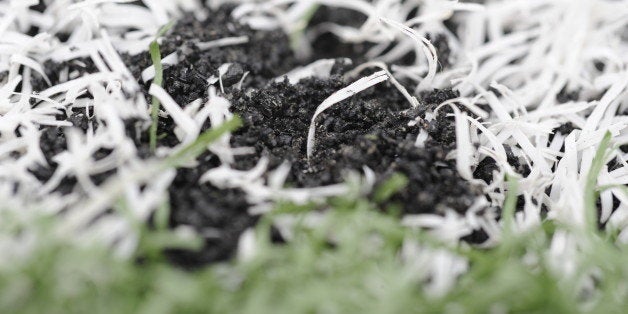
WASHINGTON -– The Environmental Protection Agency has quietly updated its website in response to a complaint that its public information on artificial turf made from old tires understated potential concerns about safety.
The recycled tire parts, sometimes called "tire crumb," are used to make pliant surfaces for playgrounds, tracks and playing fields. There are concerns that the tires contain lead and other harmful chemicals, putting children who play on the turf at risk.
In a November 2009 study and an accompanying press release and webpage, the EPA stated there was only a "low level of concern" about potential health risks posed by toxic chemicals in tire crumb. But earlier this year, the watchdog group Public Employees for Environmental Responsibility accused the agency of downplaying potential health concerns and asked it to rescind the findings. The EPA study involved only a few sites, PEER said in its complaint, making it "inaccurate, incomplete, and unreliable."
PEER announced Monday that the EPA had agreed to add a disclaimer to its original press release noting that it is "outdated," and redirect visitors to another website that more accurately reflects the state of the science on tire crumb.
While the agency did not retract the 2009 study, the website now emphasizes its "very limited nature," and states that it "is not possible to extend the results beyond the four study sites or to reach any more comprehensive conclusions without the consideration of additional data." The newer website also emphasizes the need for "future studies," and lists a number of hazardous chemicals that could be present in tire crumb -- including arsenic, benzene, mercury and lead.
The EPA on Monday explained the changes in a statement to The Huffington Post:
On March 21, 2013 Public Employees for Environmental Responsibility (PEER) sent the U.S. Environmental Protection Agency (EPA) a Request for Correction (RFC #13002), requesting that the EPA remove the tire crumb study from its official publications, rescind the study’s accompanying press release from December 10, 2009, issue a public statement about the rescinded study, and undertake a more expansive and externally peer-reviewed study concerning the potential human health and environmental effects of synthetic turf fields and playgrounds.
The EPA responded by sending a letter to PEER with an agreement to update the December, 2009 press release with a header that states, 'This news release is outdated. Visit the EPA Tire Crumb Study Web Page for the most current information.' The EPA also agreed to update the EPA Tire Crumb web page to more accurately reflect the study’s objectives and results. Presently, the web content of the press release and the study results have been updated and changed by the EPA to reflect the above agreements.
"We are gratified that EPA has taken this small and grudging step toward a more responsible position reflecting synthetic turf exposure risks," PEER Executive Director Jeff Ruch said in a statement. "EPA now admits that it has no idea about the extent of chemical exposure to children and athletes playing on these surfaces."
The Synthetic Turf Council -- the industry's trade group -- says that 4,500 fields, tracks and playgrounds in the U.S. use tire crumb turf.
The Consumer Product Safety Commission, the federal consumer watchdog agency, has found low levels of lead in some synthetic turf but said it believes they were not high enough to harm children. But the agency included a large, red disclaimer at the top of its webpage noting that its research dealt only with lead, and that it "continues to recommend that children wash their hands after playing outside, including after using synthetic athletic fields."
PEER has asked the CPSC to require that any of the turf surfaces marketed for use on playgrounds be lead-free.
